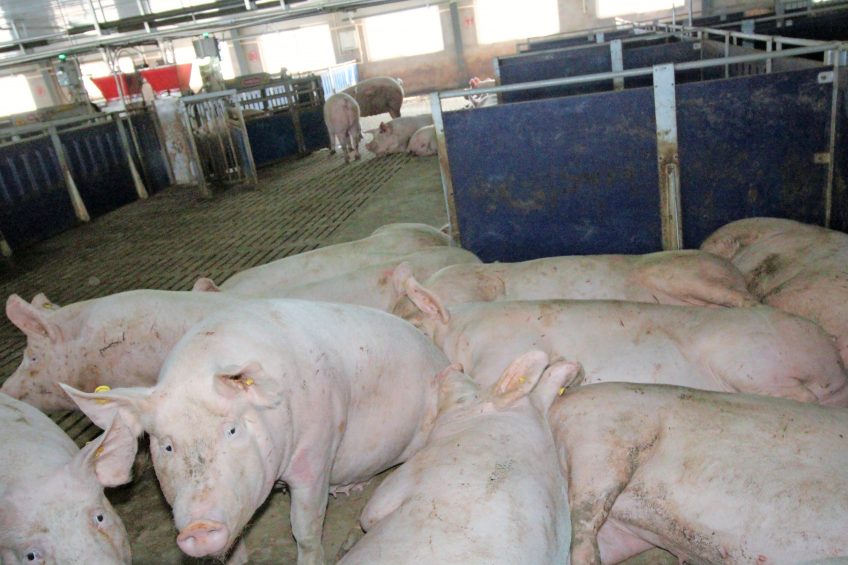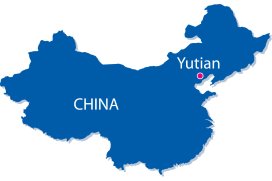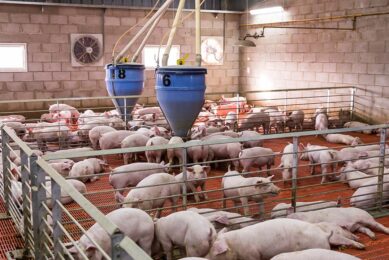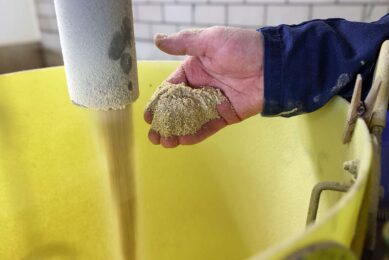DBN and its growing ambitions for Chinese pigs

DBN is short for ‘Da Bei Nong’, or Great Agriculture of the North. Headquartered in northern China, this multi-industry agribusiness is aiming for a very strong presence in the Chinese pig market. Training and educating staff well is one of the key functions of the Yutian Technology Park, near Beijing.
The grounds of the DBN Yutian Technology Park appear very well maintained. The lawns are kept short, 3 fountains in the middle spray water, and at the side of the paths, even signs have been put up as if to say ‘keep off the grass’. Dr Chen Guoyu, general manager of the DBN Yutian Techonology Park, shakes his head – the Chinese characters have a more thought-provoking message for visitors. He explains, “The sign says that, if DBN can provide service to 100 million pigs successfully, it will become one of the top 50 companies in the world and number one in the agricultural industry.”
Now there are some ambitious words, as the story of pigs and future can certainly be told at the site. Located about 2 hours drive east of Beijing, the entire complex just breathes progress, as it combines 2 pig farms in 1, aimed at research and training. In China DBN has set some serious goals – for a while, it has been one of the major players in agribusiness, but until very recently the company wasn’t too active in pigs.

DBN Yutian Technology Park, a 2 hours drive east of Beijing, is a 41 ha large, multi-purpose pig facility, essentially containing 2 separate farms complexes, a training centre and supporting facilities like a feed mill and an AI station. The research farm contains 600 sows and has a focus on feeding trials; this is complemented by a modern two-site parent stock complex with a capacity for 1,200 grandparent sows.
DBN started with 600 sows but aims for 10 mln finishers
As from 2003, there has been a 600-sow DBN research farm on this very site in Yutian County, Hebei province. The farm was set up in co-operation with the Canadian International Development Agency (CIDA), an organisation administering foreign aid programmes. For a long time, the research farm perfectly served its purpose, keeping in mind that until mid-2016, DBN ‘only’ had 40,000 sows nationwide, a relatively low number in the Chinese context.
That number, however, is about to change. In late 2015, DBN’s board members decided it was time to venture strongly into pig production. This is not only by creating integrations, but also by building own finisher farms, unlike what most other Chinese big players do. Projected size figures can only dazzle: the plan is to market 10 million finishers by 2020 and step up this amount to 30 million by 2030. In addition, the aim is to have an influence on the production of 100 million finishers in 2025.

“There were several reasons to do so,” explains Dr Chen. “First, China is the biggest producer of pigs in the world. DBN wants to cover the whole agricultural sector. That also means having a strong presence in pigs.”
He continues to say, “In addition, until recently, the feed industry was not too competitive, which led us to focus only on feed and seeds. Nowadays, however, competition is harsh. You see that for that reason more companies from the feed industry move into the pig business.”
Dr Chen also points to the booming market, as of mid-2016, prices for 1 kg of pork spiked to as high as 26-27 RMB (€3.60). “China is in transition. Most of the backyard farms are disappearing, and big producers, often feed producers, come take their place. The Wens Group is the biggest producer, their pig profit will be an estimated 15 billion RMB (€2 billion) this year. That shows how much the market is booming.”
Video: DBN is preparing its pig farmers for the future through a purpose built training centre.
Video created by: Rosie Burgin
Pig farm concentration in ‘Dongbei’
As said, DBN has grown strong in various other agribusinesses, like e.g. feed, seed and vaccine production. These feed and seed business units can be found all over China. Its headquarters are located in Beijing; true to its name, the north is where DBN’s roots are. With regard to pigs, this area is also where most future pig production will take place, it is known as ‘Dongbei’ or the north- east of China. This area was chosen by the Chinese authorities recently to be the centre of new farm constructions. Existing farms in the south can continue to exist, but newer projects should concentrate up north.
Dr Chen explains that in the coastal provinces of Jiangsu, Guangdong or Fujian, as well as in the direct vicinity of metropolitan regions like Beijing or Shanghai, permits for new swine facilities are not being granted anymore. At the same time, environmental legislation around existing swine operations has tightened. For many, this means upgrading of standards or simply relocation.
Nevertheless, for DBN as an organisation, its additional emphasis on pig production has strong implications, as the company will change. “It has been a problem to contract good staff in China,” explains Dr Chen. Sometimes even internally, existing employees are told to change jobs, in other cases employees have to be re-educated. In order to achieve excellence, DBN decided to build an own pig training and development complex adjacent to its 600-sow research farm.
DBN Yutian Technology Park
The total technology park complex has a size of 620 mu (41 ha) and is located in the middle of corn fields. Currently, the park has different functions, Dr Chen explains.

Research farm
Once the core of the complex, now occupying roughly one third of the total: a 600-sow research facility. This facility has been on the site since 2003; trials are being carried out in the field of animal health as well as feeding, e.g. to the effect of micro-organisms or probiotics in feed. Sows used usually stay for six parities.
None of the pig farms in the complex have suffered from major outbreaks, Dr Chen says. This is partly due to hygiene protocols, e.g. showering is compulsory before entering a facility, and employees cannot go from one area into another. In addition, a vaccination programme exists; for Foot-and-Mouth Disease (FMD) a mandatory vaccination is in place for piglets and sows; for Porcine Circovirus 2 (PCV2), all piglets have to be vaccinated. The farms keep free from PRRS without vaccination.

Parent stock farm
Only very recently, a two-site, multi-building breeding facility was added to the park, for 1,200 grandparent (GP) sows and some boars, for the production of parent stock. This newer part takes up the majority of the new complex. The gestating sows are kept in group housing, equipped with Electronic Sow Feeding (ESF) systems, supplied by German livestock equipment company Weda. Dr Chen believes in the ESF systems, saying that the sows have better piglets. “And the sows are generally in a good body condition.”
The produced parent stock gilts go to farms in North China, Dr Chen explains. These can be for internal use (80%) or farms outside DBN (20%). The gilts leave the farm when they are about 50 kg – or any other weight depending on the customer’s needs. The gilts are a crossbreed between Yorkshire, Landrace, Duroc and Piétrain, breeds originally acquired from Canada. The sows receive three different feed rations depending on their moment in the cycle; for the piglets and growers, four different rations are available. All rations are based on corn (mostly grown in China’s north east), soybean meal (from the Americas) and sometimes additions of wheat. All these ingredients are purchased, most diets come in pelleted form.

The farm currently achieves 27 piglets weaned/sow/year, which means that there are about 15,000 parent stock gilts that can be sold and a similar amount of barrows, which are eventually sold externally. With a farrowing rate of roughly 90% and a pre-weaning mortality rate of 4% and an average litter size of 14.3, the farm performs well. The piglets are tail docked and teeth clipped at day 1, castration occurs usually at day 5, and the piglets are weaned at 21 days (7 kg).
The farm actively aims to use fewer antibiotics. Instead, it uses a vaccination protocol and aims to include more probiotics.
Casting a glimpse into the further production chain: commercial pigs that eventually will be born from the gilts in this programme would ideally need a time of 150-160 days from birth to market, when slaughtered at 120 kg liveweight, Dr Chen says. Weaning in that case should happen between 21 and 28 days.
Manure of the parent stock farm facility can be used on DBN’s other business units, for instance at the cultivation of wheat, corn, rice or fruit trees. Part of the manure is also used for electricity generation through the biogas installations, Dr Chen explains. In northern China, where it can be cold in winter, this can lead up to a 30% electricity bill reduction, Dr Chen says.
Apart from producing PS sows, the farm is actively used for the practical side of the trainings.
Training facility
Both old and new employees, as well as external professionals and students from the China Agricultural University, find their way to the novel training facility, which consists of two multi-story buildings. DBN invests roughly 6-7 million RMB (about €900,000) per year in the programme. Lecturing rooms of various sizes can be found here, as well as classrooms and dormitories.
The lessons given combine both theory and practice as many take-home messages will be demonstrated on-farm or will even include practical presence in the parent stock farm or the trial farm. They can here observe for instance how certain feeds work for their pigs and how Electronic Sow Feeding works in practice. Also topics like environmental standards, diet composition, animal welfare and meat quality are being taught to students.
In total, annually about 1,000 professionals will find their way to the DBN training complex every year to receive training. Dr Chen continues, “In essence we have three different educations. For general managers, for production managers and for regular farm staff. How much training they receive depends on how much they know and their function.”
The complex
The entire park is conveniently laid out in a large miniature in one of the farm’s main buildings. The entire park measures roughly 520 m x 1 km, and also houses an artificial insemination (AI) station, a feed mill for 30,000 tonnes of pelleted feed/year for the different farm units on-site. In addition, there is an incinerator for processing dead animals, ponds for carp fish and many corridors which allows an easy indoor transfer from one farm house to another.
A new addition that was underway was the centralisation of a new central feed quality control laboratory in Yutian Technology Complex. This new lab will check moisture samples, will measure samples’ dry matter and mycotoxins inclusions. The laboratory will closely co-operate with the large DBN Animal Disease Centre, which is located in Huairou, north of Beijing.
Last but not least – staff. The research farm has 16-18 employees, the new parent stock farm has 20 employees. People can take four days off in a row per month – or seven days in a row per two months. Once they return to the farm, there is a compulsory two-day downtime for quarantine reasons before they actually can get near the pigs.
So what do they do then, while waiting during quarantine? Dr Chen smiles. “Other things. Then they can mow the lawn.”
DBN at a glance
DBN is a Chinese agribusiness, listed at the Shenzhen stock exchange. The Beijing-based company has long been one of the largest players in the Chinese agribusiness by focusing on providing goods and services supporting the industry, by producing i.e. seeds, animal health products, premixes and animal feed. DBN also produces vaccines, e.g. against PRRSv, PEDv, PCV2, all based on local Chinese strains. The company was founded in 1997 by Dr Shao Genhuo, a graduate from China Agricultural University. Currently, the company employs 28,000 staff, has locations all over China, had a turnover of 18-19 billion RMB (about €2.5 billion) in China alone and made a profit of 1.36 billion RMB (€186 million) in 2015.
This farm visit was possible with the kind help of Carthage & MHJ Agritech Consulting. Translation was kindly provided by Fei Yu.
 Beheer
Beheer










 WP Admin
WP Admin  Bewerk bericht
Bewerk bericht